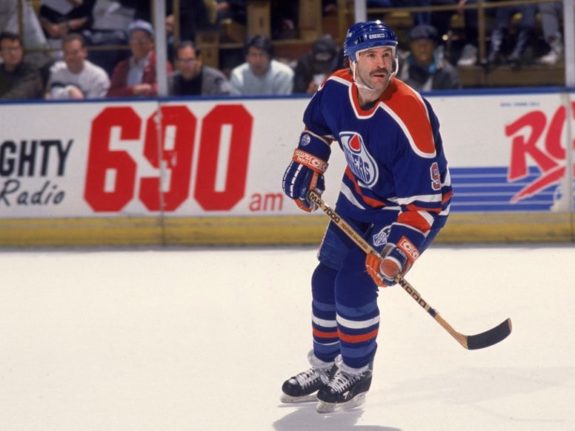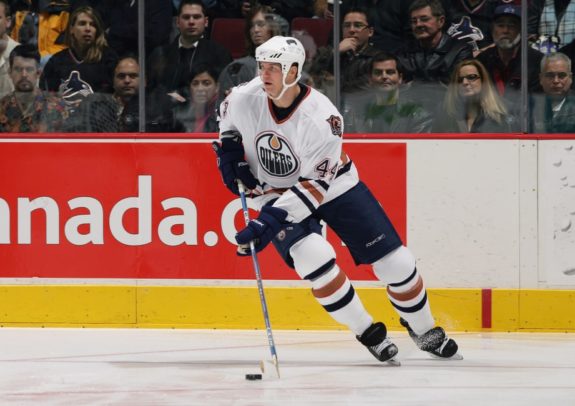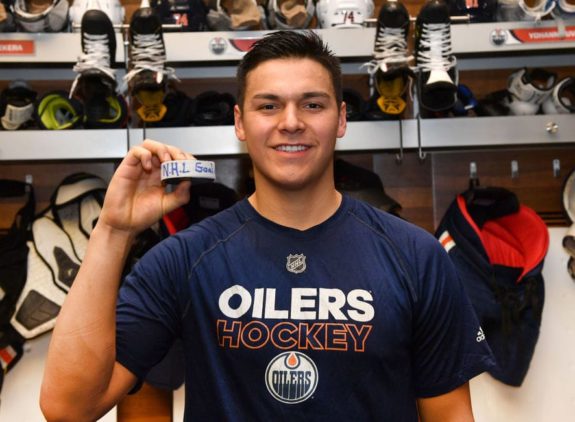The Edmonton Oilers have had tremendous success at the Entry Draft, just not consistently. Six of the seven Oilers Hockey Hall of Fame players were original draftees by the team in its early years. In 1979, they drafted Kevin Lowe (#21), Mark Messier (#48), and Glenn Anderson (#69); in 1980, Paul Coffey (#6) and Jari Kurri (#69); and in 1981, Grant Fuhr (#8).

The greatest Oiler Hall of Famer, Wayne Gretzky, of course, was never drafted, having jumped directly to the renegade World Hockey Association (WHA) in 1978 at a time when the WHA was signing underage players who weren’t eligible for the NHL’s draft. When the WHA merged with the NHL in 1979, Gretzky slid over, protected by the Edmonton Oilers in the league-merger rules, bypassing the entry draft completely.
The Best “Draft” Versus the Best “Drafting”
While it will be a few years until we find out how well the Oilers scouting staff did with their recent picks, we can debate which year the Oilers scouting staff did their best work. By this, I don’t mean which draft class they got the best players. I mean the years the Oilers got the best overall value for the rounds their draft picks were made in. I’m not talking about the best “draft,” but the best “drafting.”
To illustrate the point, let’s compare the draft number and team statistics of two Hall of Fame defencemen, Chris Pronger and Nicklas Lidstrom. For our purposes, because we are judging the value the drafting team got in drafting the player, we will consider only the years they played with their original drafting team.
Chris Pronger
Pronger was drafted second overall in 1993 by the Hartford Whalers. He played only two seasons for the Whalers, scoring 44 points in 124 games before being traded to the St. Louis Blues for Brendan Shanahan. In both seasons, the Whalers lost in the first round of the playoffs. He won no awards during that time.

Nicklas Lidstrom
Lidstrom was drafted #53 by the Detroit Red Wings in 1989. He played two decades for the Red Wings, scoring 1,142 points in 1,564 games. From 1991, when he started playing for the Red Wings, until 2011, when he retired, the team made the playoffs every year except for the 2004-05 lockout season. He helped the Red Wings to four Stanley Cups, scoring 183 points in 263 playoff games. While with the Red Wings, Lidstrom won the James Norris best defenceman trophy seven times and the Conn Smythe for playoff MVP once.
There’s a legitimate debate over whether Pronger or Lidstrom is the better player, but picking Lidstrom 53rd gave more value than picking Pronger second overall. It was better “drafting.”
2015: The Oilers Best “Drafting” Year?
Both 1979 and 1980 are usually identified as the Oilers’ best draft years. It is hard to argue with picks like Lowe, Messier, Anderson, Coffey, and Kurri.
Related: The Greatest Draft in Edmonton Oilers History: 1979 or 1980?
However, in 2015 the team got some of the most value from its draft picks. While picking Connor McDavid first overall will skew these results some, it was in rounds four and later where the Oilers’ picks rang off the crossbar bar-down like a Shinto bell resonating on New Year’s Eve. That’s where the real value to teams lies, and why teams like the Tampa Bay Lightning are so successful.
Rounds 1, 2 and 3
Picking Connor McDavid in first overall in 2015 is probably enough on its own to call this one of the best draft classes the Oilers have ever had. To date, he has scored more than 600 points, and has already won the Art Ross trophy three times, the Hart twice, and Ted Lyndsay Award three times.

Yes, picking McDavid first overall was the obvious consensus choice, but so was Nail Yakupov in 2012 and we all know how that turned out. First-overall draft choices can and do go wrong. Oilers scouts reportedly voted 9-2 multiple times in internal meetings to pick Ryan Murray over Yakupov but somehow, “The Edmonton Oilers are so proud to select, from the Sarnia Sting, Nail Yakupov,” were the words that came out of Oilers general manager Steve Tambellini’s mouth that day.
In 2012, the Oilers got it wrong. In 2015, they got it right. Very right. They had to. They had already traded away their picks in rounds two and three to other teams.
Rounds 4, 5 and 6
Even taking out McDavid, 2015 still featured some of the best value drafting for the Oilers ever. In Round 4, they picked Caleb Jones; Round 5, Ethan Bear; and Round 6, John Marino. All three are defencemen, the hardest position to predict development in.
All three of these players have already made the NHL and they could be making their mark on the league for years to come. Bear, in particular, had a spectacular rookie season for a fifth-round choice. Getting three solid NHL defencemen in Rounds 4-6 of the same year goes beyond good drafting. It is extraordinary.
Caleb Jones
Drafted #117 overall, Jones made the jump to the NHL in 2018-19. After starting in the American Hockey League in 2019-20, he finished the season in the NHL, establishing himself as a solid third-pairing defenceman with lots of upside and already the target of numerous trade rumours.

Other teams took not of Jones’ potential, which eventually led to his trade to the Chicago Blackhawks as a piece in the deal that brought back Duncan Keith. In all, he went on to play 93 games in Edmonton, which still isn’t bad for a fourth-round pick.
Ethan Bear
Just seven picks after Jones, at #124, the Oilers scouting staff did it again, picking Bear in the fifth round. All Bear did was make the NHL in 2017-18, went down to the AHL like Jones, then took off in 2019-20, where he was a regular in the Oilers’ top-four defencemen, scoring 21 points in 71 games and averaging 21:58 of ice time per game over the season.
To put that into perspective, that is more than McDavid’s ice time of 21:52 over the same period of time, and more than any other rookie in 2019-20. The performance earned Bear 10th place in the 2020 Calder Trophy voting for Rookie of the Year.

A native Cree from the Ochapowace Nation in southern Saskatchewan, Bear was enormously popular and, along with Kailer Yamamoto, was a breakout player for the Oilers in 2020.
However, despite this strong start, Bear experienced a bit of a sophomore slump in 2020-21, where he saw his production and ice-time fall with the Oilers. However, seeing that he would still have value on the trade market, Edmonton traded Bear to the Carolina Hurricanes for Warren Foegele in an attempt to add additional depth scoring to the franchise.
So, before his departure from the franchise, Bear played 132 games while averaging 20-plus minutes of ice-time each night. Once again, for a fifth-round pick, that is short-term fantastic value.
John Marino
Drafted #154 overall, in the sixth round, Marino chose not to sign with the Oilers after being drafted by them. Facing the loss of an asset, Edmonton traded him to Pittsburgh for a 2021 sixth-round pick. Marino made the Penguins in 2019-20, the year after finishing his Eastern College Athletic Conference season with Harvard University, scoring 26 points in 56 regular-season games, averaging 20:15 of ice time. Marino has since gone on to become a consistent top-four starter for the Penguins.
2015 Had the Makings of a Remarkable Draft Year for Edmonton
Choosing the best player in the world and three solid NHL defencemen far down the draft order made the 2015 Entry Draft one of the best value drafts ever for the Oilers. Few teams get one NHL’er past Round 3 each draft, so to scout three future starters is impressive in its own right.
Related: Oilers’ 50-Goal Scorers
Despite this, the long-term value of 2015 has largely been removed for Edmonton. With the trades of Bear, Jones, and Marino, the franchise will no longer benefit from their smart picks on defense. There was a possibility where two to three of their top-six defensemen came from this one class, which would have been a remarkable outcome.
Now all they have left is McDavid, which in his own right is a franchise-altering player, but can’t carry this draft class to Edmonton’s history books alone.
